स्वस्थानी नमी संरक्षण: स्मार्ट कृषि की दिशा में एक कदम
Nowadays, there is a need to consider and take a note of the water management in agriculture. Ground water level is declining rapidly and surface water is also under dwindling situations due to increased evapo-transpiration as a result of global warming and disturbed rainfall pattern. Agriculture, being totally dependent on irrigation and rainfall being the sole scarce source of water, has led to multiple problems in the past several decades.
It can be well illustrated through the meteorological data of ICAR-Indian Institute of Wheat & Barley Research, Karnal that there has been a reduction in the number of rainy days by 22% from 1972 to 2015. The rainfall distribution pattern has changed during the peak monsoon (south-west) months viz. fifty percent reduction in rainy days during July, whereas 25 percent reduction in August. Similarly 25-50 percent reduction has been observed in winter months (January & December) and 25 percent during summers.
The frequent drizzling during monsoons has changed to occasional torrential outbursts and the humidity in the atmosphere has also come down. Though macro factors in the universe have a major role in influencing the global climate, micro level environmental conditions modify at regional level. For example, evergreen trees which have high timber value and are used to protect living beings were deliberately uprooted with ulterior motives, forcing forest cover to shrink thus augmenting to climate change.
The macro level changes occurring in the recent past has led to climate change and increased detrimental effects on agricultural activities and productivity. The intensive management practices adopted in agriculture no doubt helps in quantum jump of crop productivity, but in the long run turns out to be unsustainable.
Another notable change in agriculture management is the stretching of the production cycle all the year round due to which the water requirement has gone up many folds and the slightest failure of monsoon has devastating effects on the crops, unlike earlier situations where a minimum crop was always guaranteed.
Drought and drought like situations always loom around but with the arrival of monsoon, the menace of the drought has become the thing of the past. Everyone sleep till the next summer to wake up only to put the blame on nature or others. Little efforts from our part would go a long way in managing drought and flood like situations.
An attempt should be made to keep each and every single drop of rain within our own land. The basic principle in managing rainwater is “to make the running water walk, walking water to stand and standing water to sleep”.
Principle 1: Making Running Water to Walk
The mentioned phrase refers to the decline in speed of running water so as to make it walk. It can be achieved by constructing any kind of barrier/obstruction in the path of flow of rainwater. Nature restricts the speed of moving water through trees, shrubs, herbs and grasses having extensive root system and foliage.
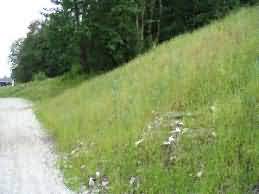
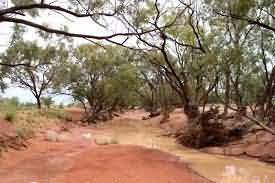
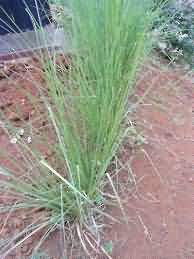
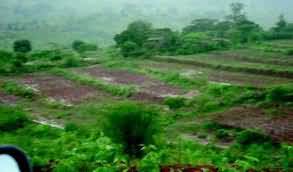
Natural ways to slow down the speed of moving surface water
Therefore in order to slow down this process we should keep in mind and follow the rules and principles of nature. A three tier vegetative shield all along the border of the farm/field may be built in order to ensure sufficient protection against sun and wind and also constitute enough green matter not only for mulching and composting but also for botanical decoctions against pest and diseases or as nutrients.
Where it is not necessary, one must not expose the soil and therefore avoid clean weeding and hoeing. In fields including undulating area or hilly terrain, contour trenching (Fig 1a), bonding, terracing with vegetation(Fig 1b), establishment of gully plugging or any other suitable mechanical structures are effective means to slack off the speed of running water.
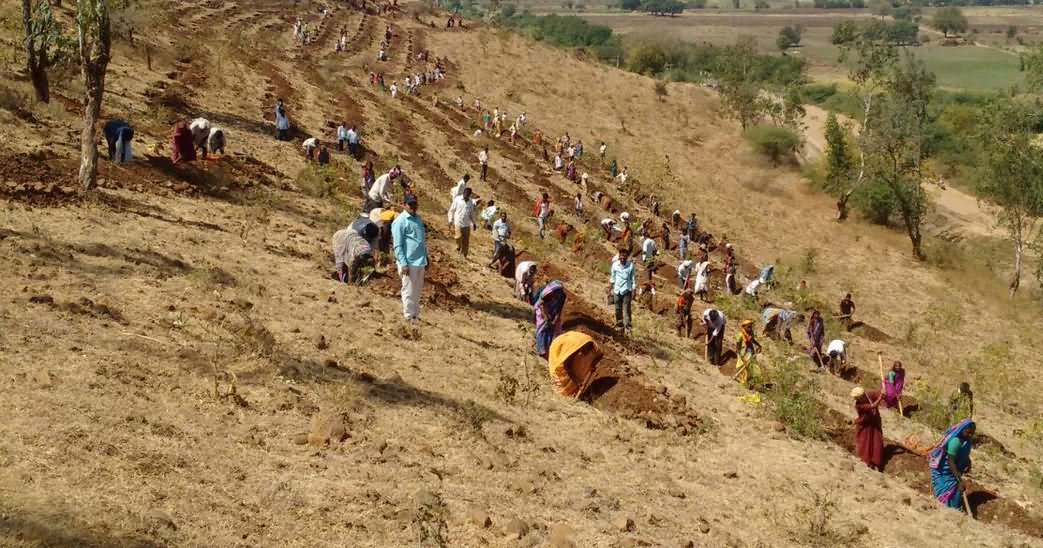
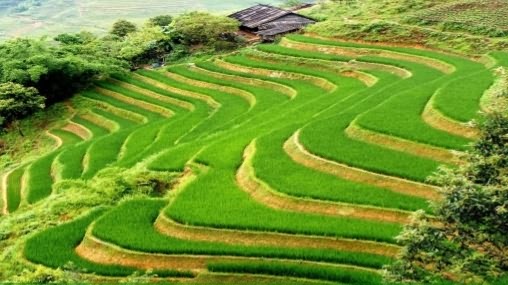 a b
a b
Fig. 1: (a) Contour trenching at hilly area (b) terracing with vegetation hills
Principle 2: Making Walking Water to Stand
Here, our motive is to store the water in the soil profile or soil layers. In the field, it can be achieved by allowing maximum infiltration of the rain water into the soil layers. Thus it is imperative that there should be sufficient soil (top soil and sub soil); above the hard crust.
It is worth remembering that it takes thousands of years to make one inch of top soil and the same could be washed off in a few years due to excess and inappropriate human intervention. Deep summer ploughing before monsoon is a reliable technology for storing maximum rain water in soil profile during the monsoon period.
Deep summer ploughing keeps top and sub soil open and breaks the hard crust which facilitates fast infiltration of water in deep soil profiles. Besides water conservation or storing rainwater in soil profile, summer ploughing also serves a means for natural pest (insects, pathogens and weeds) control in agriculture. Therefore, this technology also helps bring down the cost of cultivation.
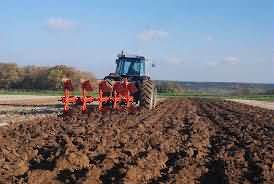
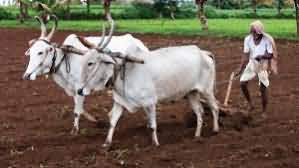
Mulching the soil with the crop residues or growing of cover crops especially legumes, not only facilitates water to stand in soil but also protects the soil from erosion and also improves fertility. Thus through these techniques, walking rain water is provided with adequate time to stand in the soil and infiltrate down.
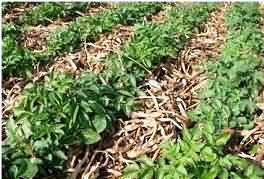
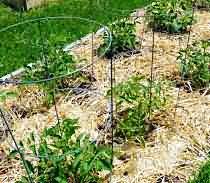
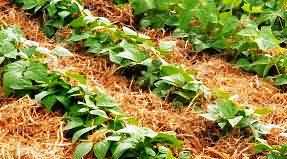
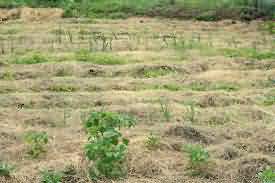
Digging of water pits at regular intervals also helps walking water stand in the field for longer time encouraging infiltration. Water pits can be made in gentle sloping lands with a suitable size for example viz. 2’× 2’ × 2’ (the size may reduce or enhance depending on the field situation) and about 100-150 could be made in one hectare of land. A word of caution, in too steep slopes, land-slides may occur if too much of water is allowed to stand in the soil.
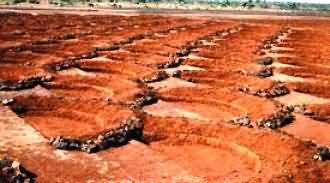
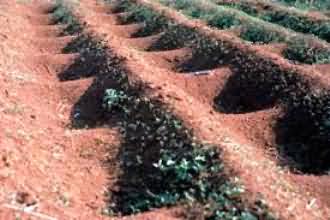
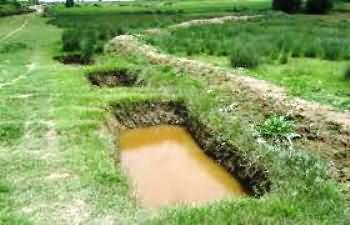
Principle 3: Making Standing Water to Sleep
This expression is meant to denote the withdrawal of destructive energy of the rain water so that it remains still in a storage system. The storage system could be a rain water harvesting well, check dam, sub-surface dykes, ponds (Fig. 2a) or polythene lined storage ponds (Fig. 2b), percolation tank, mini percolation tank (MPT), cement tanks etc. The stored water is judiciously used in times of need for sustaining production or at least to provide life saving irrigation.
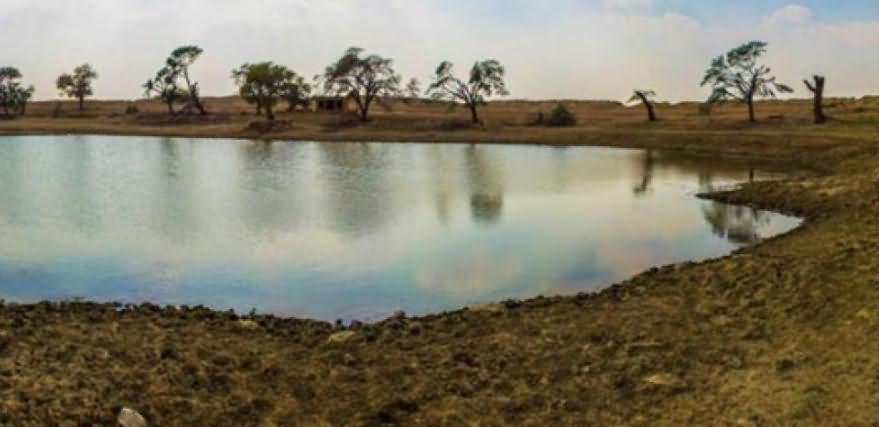
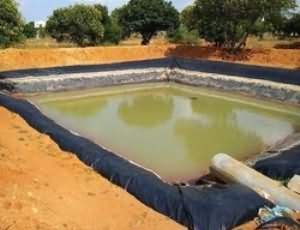
Fig. 2(a) Pond build to store the water (b) Pond build up by the use of reinforcement and polyethylene
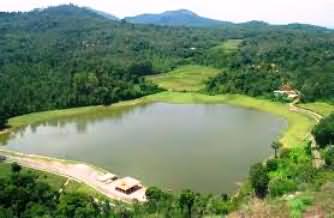
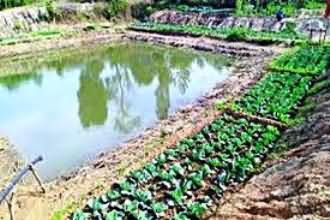
Judicious Use of Stored Water
Conventional methods of irrigation require huge amount of water as well as more labor to implement it. Modern systems of irrigation such as drip, sprinkler, micro-sprinkler, rain-gun, pivot, mist or fogger increases water use efficiency and, also provides opportunity for fertigation or application of pesticides. These can be practiced with other agronomic practices in combination to ensure higher water use efficiency.
Mulching of the farm with dried leaves or agro-wastes prevent soil moisture loss. Application of organic manures such as farm yard manure, green manure, compost, leaves of trees etc. enhance humus content of the soil thereby boosting the water holding capacity of soil.
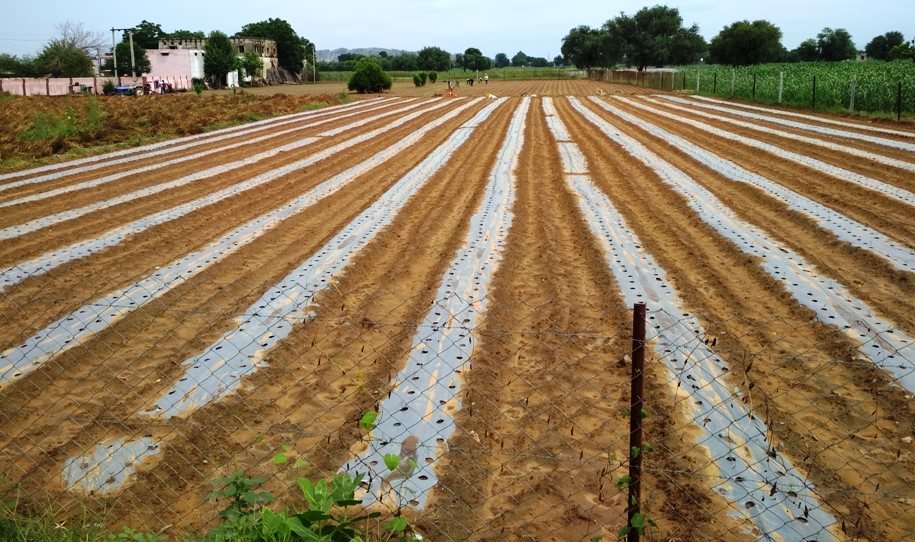
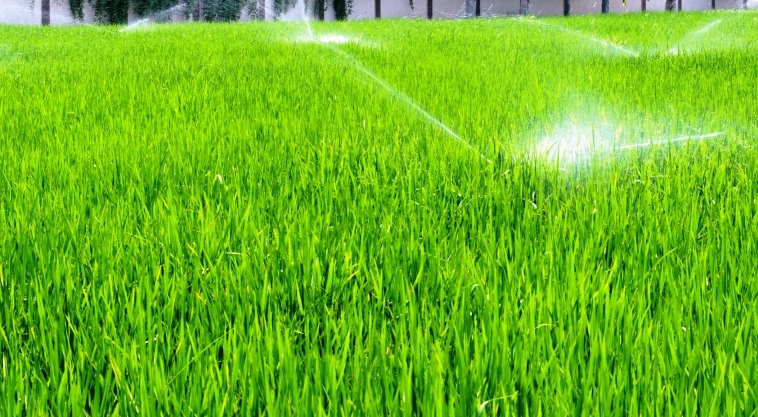
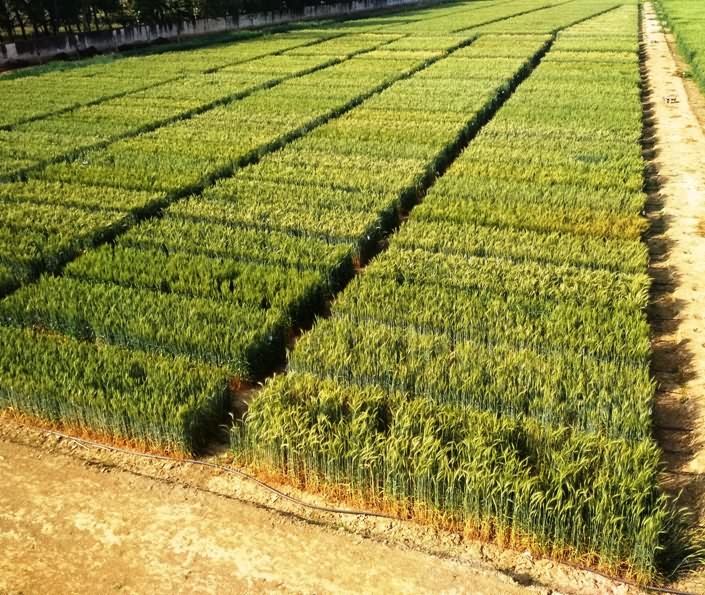
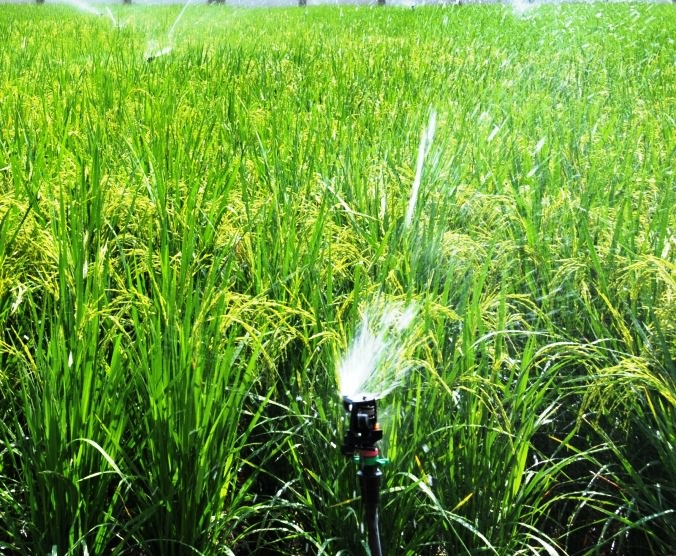
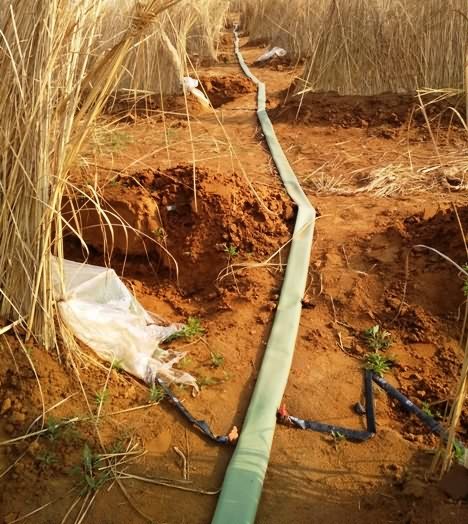
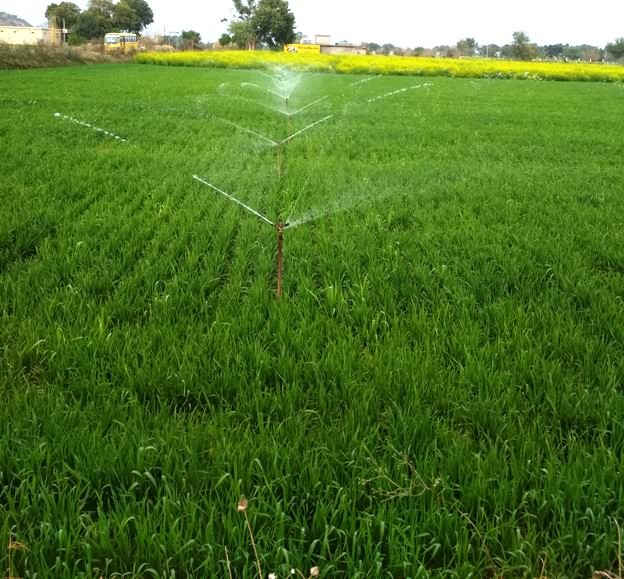
How Much Water is available for in-situ moisture conservation and use?
Stored water will help us to irrigate the field and recharge surface water as well as ground water level. Wells and tube wells accounted for 29% total irrigated area in 1951 and in 2010-11 they share almost 64% of the total irrigated area (Source: Department of Agriculture and Cooperation, Agriculture Census 2010-11).
The increased percent share indicates our dependence on groundwater for irrigation. Therefore, we need to recharge it during monsoon months in-order to maintain the balance between inflow and outflow.
The total geographical area of India is 328.7 Mha and average annual rainfall of India is near around 1190 mm. Total cultivable area of India is 159 Mha. Therefore, we can conserve 159 Mha x 1190 mm = 189 Mha.m which is around 1900 Million litres.
Currently, we are using 48% of precipitated water (Dhawan, 2017); if we could increase this percent to 70-80% we shall be able to reduce water scarcity. Most drought prone state of India is Rajasthan however, this state could conserve good amount of water as the total geographical area of Rajasthan is 3.42 Mha and average annual rainfall is 530 mm.
Since, the total cultivable area of Rajasthan 2.56 Mha therefore, we can conserve 2.56 Mha x 530mm = 1.35 Mha.m water or 1350 Million litres of water.
Conclusion
Rainwater is an indispensable source which needs to be conserved at any cost. We can conserve it in urban and rural areas at both individual and community levels. Public participation shall ensure water movement at a mass level which shall relieve us from this formidable problem.
References
Dhawan, V., 2017. Water and Agriculture in India: Background Paper for the South Asia Expert Panel During the Global Forum for Food and Agriculture (GFFA) 2017. OAV German Asia-Pacific Business Association.
Authors
Raj Pal Meena, K. Venktesh, Ankita Jha and Suraj Goswami
ICAR-Indian Institute of Wheat & Barley Research, Karnal-132001 (Haryana)
Email:
